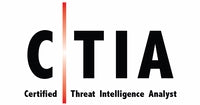(301) 220 2802
If you’re excited by the possibility of using your critical thinking skills and analytical mindset to advance your cybersecurity career, then you should consider becoming CTIA certified.
TrainACE’s 3-day, instructor-led Certified Threat Intelligence Analyst (CTIA) training will prepare you for the EC-Council CTIA exam and open up a range of new opportunities in defensive cybersecurity operations.
CTIA qualified professionals are increasingly in-demand, as organizations seek to protect their digital infrastructure from increasing numbers of cyber-attacks.
Our instructor-led class utilizes EC-Council’s CTIA labs to give you a perfect mix of hands-on experience and classroom instruction, preparing you to pass the test, but just as importantly, preparing you for real-world operations.
Got Questions?
For more information about your specific needs, call us at (301) 220 2802 or complete the form below:
Learn More About CTIA
Jump To:
Class Schedule
-
Greenbelt & Live-Online
11/12/24 - 11/14/24
Tue-Thu (8:30am-5pm)
-
Greenbelt & Live-Online
01/21/25 - 01/23/25
Tue-Thu (8:30am-5pm)
-
Greenbelt & Live-Online
03/17/25 - 03/19/25
Mon-Wed (8:30am-5pm)
Get your Certified Threat Intelligence Analyst Training and Certification (CTIA) training in our convenient IT training centers in Maryland or Virginia.
Why Take TrainACE's CTIA Training?
CTIA Certification is NICE 2.0 Compliant
The CTIA certification maps to the NICE framework for roles listed under threat intelligence, enabling you to apply for US government information security roles. This opens up a wide variety of opportunities in Maryland and Washington DC, where many government agencies are headquartered and increasing numbers of government sub-contractors are adopting NICE standards for recruiting IT staff.
Increased Job Prospects and Promotion Opportunities
Cyber threat intelligence is an area of the IT industry that is growing rapidly. There are more open roles than skilled technicians to fill them. This means that if you have the credentials to prove your experience and skills in threat intelligence, you stand a great chance of landing a well-paying and rewarding role.
TrainACE's CTIA Training Class
In preparing you for the EC-Council CTIA exam, TrainACE’s threat intelligence class offers you the knowledge and skills you need to advance your career. At the same time, our hands-on approach prepares you for real-world situations and increases your employability as a threat analyst.
TrainACE’s Certified Threat Intelligence training class covers all the stages of the threat intelligence lifecycle and is in demand by top organizations worldwide.
Hands-On Learning
Our classes utilize EC-Council’s CTIA labs to give you an optimal mix of hands-on experience and classroom instruction. With a 60:40 theory-to-practice ratio for CTIA you will gain valuable hands-on experience with the latest threat intelligence tools, techniques, frameworks, methodologies, scripts, etc.
EC-Councils CTIA labs simulate real-time environments which consist of the latest operating systems including Windows 10 and popular penetration testing platforms like Kali Linux for planning, collecting, analyzing, evaluating, and disseminating threat intelligence.
Much like a ‘hunter-killer’ team, you’ll be deployed as a ‘Blue Team’ operative, tasked with threat identification, and asked to employ the tools at hand to thwart active and potential cyberattacks.
Who Needs CTIA Training?
TrainACE’s Certified Threat Intelligence Analyst training is great for a wide range of cybersecurity professionals. The primary candidates are likely to be ethical hackers, threat hunters, and threat analysts, so, this is a great next step after gaining CEH or similar credentials and experience.
CTIA will also appeal to SOC Professionals or anyone with job roles related to Ethical Hackers, Security Practitioners, Engineers, Analysts, Specialists and Architects, Threat Intelligence Analysts, Associates, Researchers, and Security Consultants.
If you manage IT security teams, digital forensic and malware analysts, or an Incident Response Team, offering CTIA training to your staff will strengthen their roles as threat intelligence experts and better position your organization's IT security.
What Jobs Can I Get With CTIA Certification in the Washington, DC Region?
IT professionals with threat intelligence credentials are in high demand in the Washington, DC region and Maryland. Professional certifications are a great way to get in front of recruiters and hiring managers. Threat intelligence analysts are highly respected in the industry and there is no shortage of threat intelligence jobs in the metro Washing DC area.
Here are some examples of job titles for threat intelligence professionals available in the Washington, DC region:
- Crypotlogic Technician – US Navy, Columbia, Maryland
- Multi-Source Support Specialist TS/SCI – Leidos, Annapolis Junction, Maryland
- All Source Intelligence Analyst – System One, Chantilly, Virginia
- Researcher: Threat Intelligence – Control Risks, Washington, DC
- Intelligence Intern – Strider, Washington, DC
- Marine Interdiction Agent - US Customs and Border Protection, Washington, DC
What Do I Need To Know Before Taking CTIA Training?
TrainACE’s CTIA training class is not considered an entry-level class. Successful candidates will typically have two or more years of experience in the information security profession. Candidates with Certified Ethical Hacker (CEH) certification, or equivalent will find their prior knowledge and skills helpful in understanding the advanced knowledge and skills taught in the CTIA class.
If learning the complete threat analysis process and working in threat intelligence is something that excites you, but you have limited IT experience, then you should look to a career path that starts with the fundamentals, e.g., CompTIA A+ and Network+, then progress through CompTIA Security+ and/or EC-Councils CEH certifications. This will give you time to build work experience in the information security field as well as gain valuable accreditations on the way.
What Are the CTIA Exam Requirements?
Exam Eligibility
As you consider how you are going to prepare for the CTIA exam there are two methods for taking the test:
- If you decide to self-study, you must submit an exam application that demonstrates you have at least two years of information security experience, and you must pay a $100 non-refundable exam application fee.
- However, if you opt to take training through an accredited partner, such as TrainACE, attending the class qualifies you for the test, and the exam application fee is included in our original tuition fee.
The CTIA Exam
To demonstrate your mastery of the skills and knowledge needed to work in threat intelligence you need to gain a 70% passing score in the CTIA exam. The exam consists of 50 multi-choice questions and you have a maximum of two hours to complete the test.
You can take your CTIA exam at our Pearson VUE exam center when you are ready.
A TrainACE advantage is that, should you fail the first exam after attending the full class, you’ll be able to re-take the class, and we’ll give you a second exam voucher for free.
What Skills Will I Learn in this CTIA Class?
During the our CTIA training you will learn:
- The fundamentals of the Information Security domain
- The critical role that a threat intelligence program plays in incident response, risk management, and security information and event management (SIEM).
- Various cyber threats and threat actors and discuss the various objectives of cyber attacks.
- The threat intelligence fundamentals such as life cycle, threat intelligence types, frameworks, capabilities and maturity models.
- About the Advanced Persistent Threat (APT), Cyber kill chain methodology, the pyramid of pain and Indicators of Compromise (IoCs).
- The threat intelligence methodology, including the Requirements, Planning, Direction, Review steps.
- Data collection methods, data feed types and sources.
- Methods of collecting and acquiring intelligence data via HUMINT (Human Intelligence, OSINT (Open-Source Intelligence), malware analysis, CCI (Cyber Counterintelligence), and IOCs (Indicators of Compromise).
- How to use structuring, data processing, normalization, storing, sampling, and visualization for bulk data collection and management.
- Methods and types of data analysis such as SACH (Structured Analysis of Competing Hypotheses), Statistical Data Analysis.
- How a comprehensive threat analysis process uses knowledge base creation , threat modeling, evaluation, fine-tuning, and runbook.
- A variety of tools used for threat modeling, data analysis, and threat intelligence tools.
- The best ways to develop threat intelligence reports thare are effective.
- Platforms for sharing threat intelligence as well as the acts, and regulations governing the sharing of strategic, tactical, operational, and technical intelligence.


